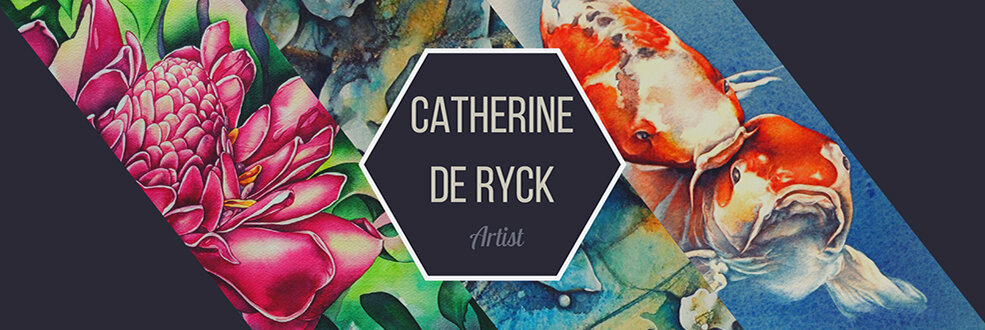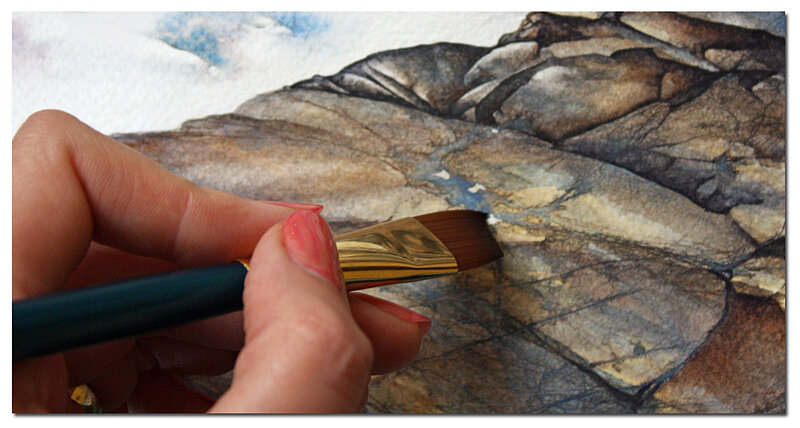Peindre les rochers / Painting rocks
J'aime peindre les rochers. Là où certains ne voient qu'une succession de masses grises ou brunes, j'observe une grande variété de couleurs, nuances, reflets et textures. Les rochers sont un thème éternel à explorer, des pierres luisantes balayées par les flots aux rochers arides du désert. Mes préférés sont les rochers déchiquetés et aux allures irréelles que l'on retrouve dans les grands espaces ; ils sont plus riches en couleur, contaste et textures.
Ma technique consiste en trois étapes :
- J'applique les premiers lavis, constitués des nuances les plus claires de la pierre
- Dans l'humide, je dépose les tons moyens et foncés. Les auréoles et autres effets sont les bienvenus car ils contribuent à la création de textures additionnelles
- J'ajoute davantage de lignes et de détails à la brosse sèche pour un aspect plus réaliste.
Il est également important de bien choisir ses pigments. En fonction du résultat que l'on souhaite obtenir, l'utilisation de pigments naturels et minéraux peut s'avérer un atout. Ceux-ci sont plus lourds que leurs homologues synthétiques et ils produisent des effets intéressants tels que la sédimentation ou la granulation. Pour les rochers représentés ci-dessous, ma palette était constituée de terre de sienne brûlée, terre d'ombre brûlée, bleu céruléen et outremer, ainsi que de deux teintures (pigments synthétiques) utilisées dans les mélanges de noirs profonds : magenta quinacridone et bleu phtalo.
I enjoy painting rocks. Where others see brown or grey masses. I observe a wide variety of colours, shades, relfections and textures. Rocks are an endless theme to explore, from the wet stones washed by rivers to the arid rocks of the desert. My favourite are often jagged, unreal-looking rocks in a rough landscape, as they are richer in colour, contrast and textures.
My technique can be divided in three steps:
- I apply the first washes, constituted by the lightest shades of the stone
- While the painting is still wet, I layer the medium and darkest colours. All backruns and effects are welcome, as they create additional texture
- Using the dry brush technique, I add more details and lines for a realistic look.
It is also important to choose the right pigments. Depending on the look that you want to achieve, using natural and mineral pigments can be an advantage. These pigments are heavier than their synthetic homolgues and they produce some interesting effects like sedimentation or granulation. For the rocks depicted above, my palette was made of burnt sienna, burnt umber, cerulean and ultramarine blues, as well as 2 staining (and synthetic) pigments used for mixing deep darks: quinacridone magenta and phtalo blue.






/https%3A%2F%2Fassets.over-blog.com%2Ft%2Fcedistic%2Fcamera.png)
/http%3A%2F%2Fstorage.canalblog.com%2F33%2F70%2F277354%2F128164662_o.jpg)
/http%3A%2F%2Fstorage.canalblog.com%2F07%2F18%2F277354%2F128164758_o.jpg)
/http%3A%2F%2Fstorage.canalblog.com%2F36%2F98%2F277354%2F128164684_o.jpg)




